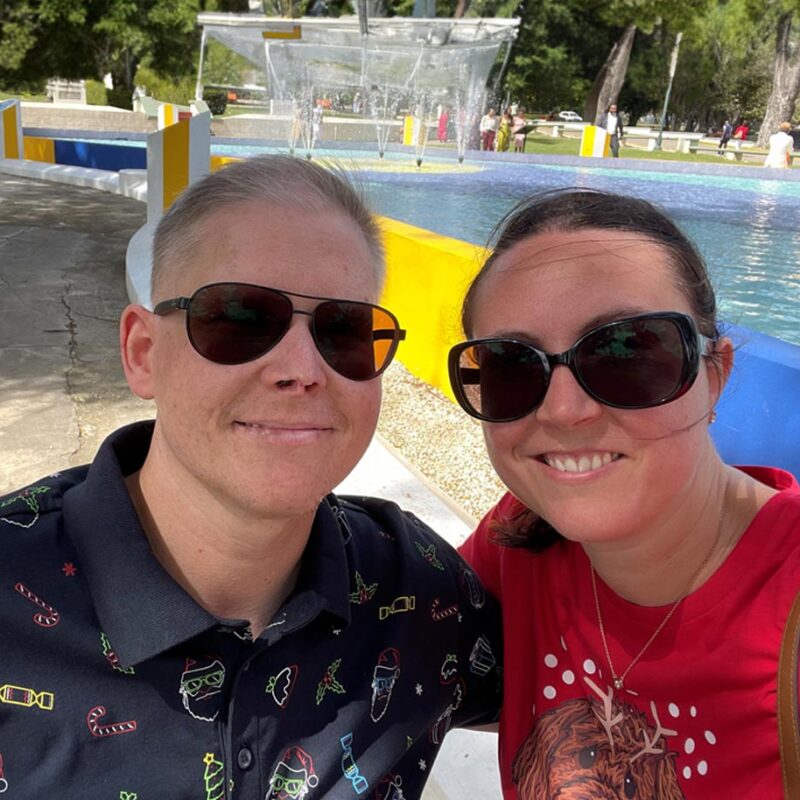After being hospitalised with suspected necrotising fasciitis, Andy discovered he had developed sepsis and narrowly avoided having his leg amputated. However, it could have been much worse…
If it wasn’t for his wife insisting on calling 111 when she did, Andy might have lost his life: “I think I would have toughed it out.. and that would have probably ended up killing me.”
Andy is now sharing his experience as part of our Sepsis Voices Campaign to urge people not to fall victim to a ‘put up, shut up’ mentality when presented with sepsis symptoms.
In 2018, Andy woke up with an itchy knee, which became more inflamed and irritable as the day progressed. Despite being out celebrating his daughter’s Confirmation, he asked his dad to take him home early, where he went to bed feeling tired and lethargic.
When checking in on him, a family friend noticed his leg was swollen and inflamed, but Andy was dismissive of his symptoms: “It just felt like I had a bad reaction to a bite or something like that.”
He woke up early the next morning feeling woozy, when his wife—realising that he wasn’t himself—insisted on calling 111. “I didn’t feel with it, I got back into bed and said to my wife I just don’t feel great, and I think she realised at that point that I wasn’t well.” After ringing 111 and discussing his symptoms over the phone with a doctor, an ambulance arrived within 15 minutes and Andy was taken to A&E, where he stayed overnight.
Andy spent the next two weeks in high dependency: “I was wired up to various machines, I had very serious AFib, my heart rate went up to 150 beats-per-minute, they couldn’t cool me down.. I ended up very delirious.”
He had surgery on his shin as doctors suspected necrotising fasciitis. That surgery has left him with a dip in his shin that would suggest that some flesh was removed.
Subsequently when he was in the delirious state, Andy was sent for additional surgery which, if it had been carried out, would have seen his leg amputated. The drawing of blood from his upper leg was what stopped the surgeon conducting that operation, likely saving his life.
During this time, the full emotional weight of the situation struck Andy, whose first thought was of his family: “That was probably my low point, at that point I did start to turn a corner, partly because we’ve got three children and everything, I’ve just got to survive, I’ve got to get through this.”
Thankfully, he was given the all-clear after having his shin stitched back up and he was able to leave hospital in just under two weeks. However, Andy admitted his initial dismissiveness almost cost him his life:
“I have to thank my wife because I think I would have toughed it out and that would have probably ended up killing me… ‘It’s a swollen knee, I’ll take some paracetamol, stop being a moan’, that would have been my mentality.”
Lethargy, confusion, and swollen or inflamed body parts can be symptoms of sepsis. Andy’s experience therefore carries a warning for people who are reluctant to take the signs and symptoms of sepsis seriously and get themselves checked out, an attitude that Andy partly attributes to his parents’ generation: “I guess their era was get on with it basically, put up, shut up, take a tablet, move on.”
This mentality almost cost Andy his life, who was keen to emphasise to others the need to heed such warnings:
“Don’t be too dismissive if something doesn’t feel right… if a swollen knee is getting redder and hotter, and you’re starting to feel not quite with it, then that’s probably not just a fever.”
Andy was also surprised at the seemingly innocuous nature in which his sepsis had first developed. Indeed, the doctors did not know for sure exactly what it was that had caused his sepsis: “They couldn’t actually say with any certainty how or where my sepsis came from.. and I’ve always wondered, ‘how the hell did it start?’”
Sepsis can develop from any form of infection, even from a common cold or flu, and so there is no strict pathway when it comes to contracting sepsis. Andy himself believes it might have developed from a colonoscopy, but his case still remains a mystery. This points to just how common and easily contractible sepsis is as a condition; more people die every year from sepsis-related illnesses than they do bowel, prostate, and breast cancer combined. The dangers of leaving it too long before seeking medical help for sepsis symptoms can always be mitigated by asking the vital question: ‘Could it be sepsis?’
Like many other sepsis survivors, Andy experienced psychological hurdles upon leaving hospital: “I struggled the following year… I had an unreasonable manager who didn’t care and I didn’t have the wherewithal to fight it. I was stupid, I should have stayed out for longer.” It is highly common for sepsis survivors to suffer from Post Sepsis Syndrome (PSS): Around 40% of people who develop sepsis are estimated to suffer physical, cognitive, and/or psychological after effects.
Andy commented that his diagnosis also had a massive impact on his family: “That was a consequence of it because my wife, she knew there was this risk I was going to have my leg amputated, and she just didn’t know how we would cope, and I think the stress of that triggered her own health problem.” Reflecting on the anxiety of being away from work with sepsis, and the importance of spending time with family, Andy urged other sepsis in-patients and survivors not to feel too pressured:
“Prioritise yourself and your family, work will always be there, and there are things that can protect you… work is not the most important thing in life, and what is important is your family… they are the ones that will always be there for you.”
Andy is sharing his sepsis story to raise awareness of the signs and symptoms of sepsis—knowing them helps save lives.





